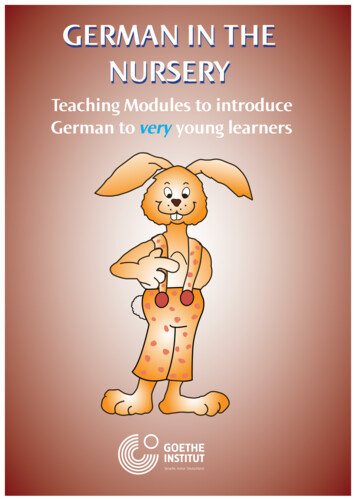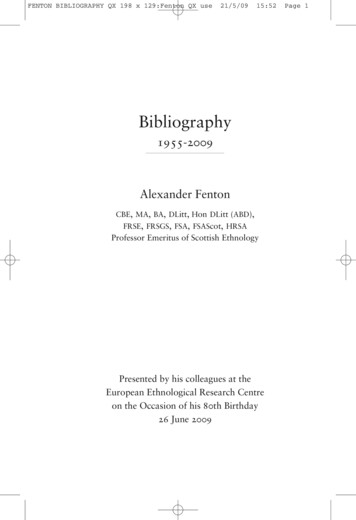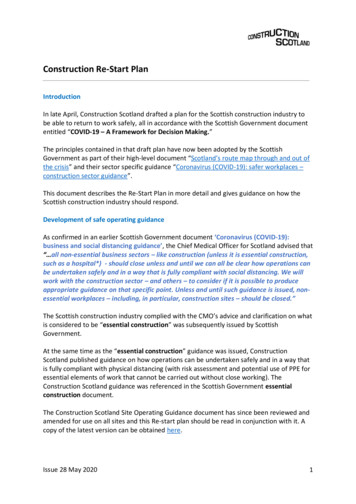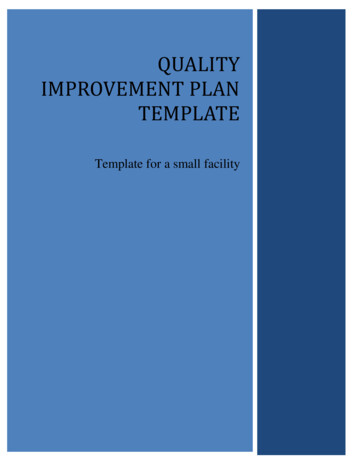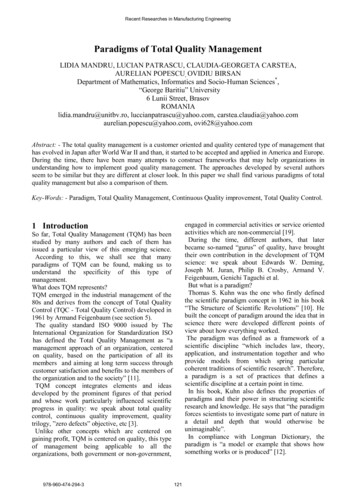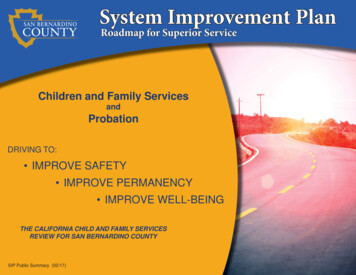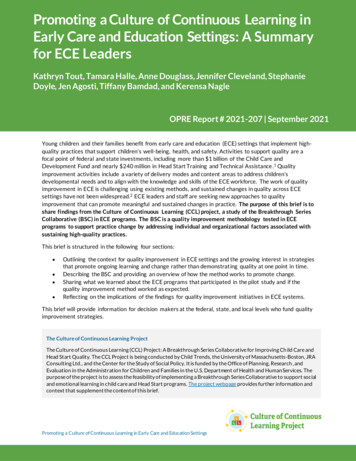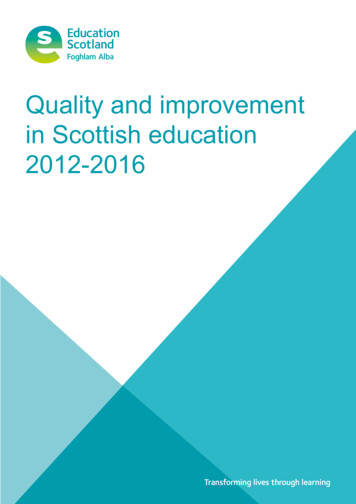
Transcription
Quality and improvementin Scottish education2012-2016
Quality and improvement in Scottish education 2012-2016IntroductionWelcome to this report on quality and improvement in Scottisheducation.This report summarises findings from inspections and otherevaluative activities carried out by Education Scotland overthe period January 2012 to June 2016. It seeks to draw outsome of the key features and trends that we have seen aseducation providers have sought to develop and improve theirservices over that period of time.The report brings together messages from across the full range of sectors in whichwe carry out inspections and reviews, ranging from early learning and childcare toadult learning. It identifies some key areas of strength. It also identifies some keyareas where there is a need for more focused effort to achieve furtherimprovements.Our intention in publishing this report is to feed back the intelligence we havegained from our broad, nationwide programme of inspection and evaluativeactivities so that service providers, and those that lead and manage these services,can benefit from our findings as they plan their next steps in continuousimprovement.As the national improvement agency for Scottish education, Education Scotlandgenerates evidence from a wide range of inspections and other evaluative activities.That includes local authority scrutiny and thematic reviews of particular topics aswell as our routine establishment and service inspections. We use all of thisevidence to report publicly on the quality of education. Our inspectors report on theimpact that national policy and guidance is having in establishments and servicesacross the country, and they make professional judgements about the quality ofchildren’s and young people’s learning, attainment and achievement.The scope of our activities gives us a unique evidence base drawn from observingpractice at first hand across the whole country. This rich evidence base enables usto draw conclusions about what is working well and what needs to improve. We areable to use this perspective to shape the advice we provide Scottish Ministers andtheir officials to promote improvement in Scottish education.During the period covered by this report, Scottish education has gone through aperiod of very significant reform impacting on every part of the system. Across allsectors, establishments and services have focused strongly on developing theirprovision to take account of key national policies and their associated strategies.Getting it Right for Every Child, Curriculum for Excellence and Developing theYoung Workforce have become well established as major drivers for reform, whilst arange of other targeted national programmes have sought to tackle more specificissues.In early learning and childcare the Children and Young People (Scotland) Act 2014replaced the previous entitlement to ‘pre-school education’ with a new, flexibleentitlement. This delivered an increase in publicly funded hours to 600 for eachchild annually as part of expansion of early years provision. In early learning andchildcare settings, schools and colleges, we saw the continuing development andimplementation of Curriculum for Excellence, including the phased introduction ofthe new National Qualifications. Since the publication of Developing the YoungWorkforce, Scotland’s Youth Employment Strategy, in June 2014, there has also1
Quality and improvement in Scottish education 2012-2016been a greater focus on developing young people’s employability skills across allsectors. There have been improvements to teacher education and continuingprofessional development flowing from the Teaching Scotland’s Future report andthe development of new strategies for the youth work and adult learning sectors.There has also been new legislation placing an enhanced duty on all public sectorpartners to promote community empowerment.Scotland’s colleges have experienced a period of major structural change whichinvolved the merger of many local colleges into regional colleges. Post-16legislation altered the status of colleges bringing with it alterations in collegegovernance. The move to a regional configuration involving large multi-campuscolleges, along with regional outcome agreements and continuing resourceconstraints, has presented major challenges as well as substantial opportunities forthe college sector.From 2015 onwards, Scottish education has also experienced an emphatic increasein the focus being placed nationally on tackling the gap that exists in attainmentbetween children and young people living in the areas with greatest and lowestlevels of socio-economic deprivation. Closing the poverty-related attainment gaphas been raised to the very top of the Scottish Government’s agenda. To accelerateprogress and effective practice, the Scottish Government has dedicated substantialresources to the task through the Scottish Attainment Challenge, with a commitmentto making available 750 million over five years to support intervention,proportionate to need, which is likely to involve almost every school in the country.All these changes have taken place in a context of continuing constraints on publicspending. These constraints have naturally been felt at all levels of the educationsystem although teacher numbers have been protected through an agreementbetween the Scottish Government and local authorities. The capacity of localauthorities and schools to deal with the impact of resource constraints has variedsubstantially. In response to constrained budgets and the need to make savings, wehave seen many local authorities make substantial efficiencies at the centre, ratherthan in classrooms and front-line services. That has resulted in many authoritieshaving a reduced capacity to undertake key functions such as supporting qualityimprovement, monitoring and challenging school performance and leading andcoordinating professional learning. There is now therefore an even greater focus onleaders and practitioners in education establishments and services driving their ownimprovement through robust self-evaluation and improvement methods.During the period 2012 to 2016 our programmes of inspection and review alsocontinued to develop and evolve. We introduced new programmes of evaluationsuch as the external reviews of career information, advice and guidance servicesthat we now undertake in partnership with Skills Development Scotland and ournew approach for inspecting educational psychology services. More broadly weincreased our focus on Developing the Young Workforce and employability skills inour evaluative activities.To support the successful implementation of Curriculum for Excellence, we madeyear-by-year adjustments to the criteria inspectors applied when evaluating thecurriculum and arrangements for self-evaluation and improvement. We plannedthese adjustments to align closely with the Curriculum for Excellence nationalimplementation plan to help promote progress and to provide feedback on howimplementation was proceeding. In this context of deep and comprehensivecurricular reform, our inspectors found that it proved challenging for establishmentsand services to move in one bound to establish a curriculum which delivers fully onthe aspirations of Curriculum for Excellence. This is reflected in a relatively highlevel of variability in the quality indicator grades inspectors awarded for ‘curriculum’and ‘improvement through self-evaluation’ during the period of this report.2
Quality and improvement in Scottish education 2012-2016Looking across the evidence brought together in this report I believe it is clear thatthere are many strengths in the quality of professional practice and provision acrossScottish education. Our inspectors have observed many examples of outstandingand innovative practice which are securing very positive outcomes for children andyoung people. It is equally clear, however that there are also important areas whereleaders’ and practitioners’ efforts to improve need to be more focused.This report reflects the distance that Scottish education has travelled since 2012,capitalising on the range of reforms that have been under way. It also shows clearlythat there is still further to travel on that journey if we are to realise our collectivenational ambition of achieving excellence and equity for all Scottish learners.In the years ahead the need for education practitioners to manage change and seekimprovement will certainly not cease, but the direction of travel is ever clearer. TheNational Improvement Framework, launched at the start of 2016 and refreshedagain for 2017, is providing, for the first time, a new level of clarity about ourcollective national priorities for improving education provision. It sets out a clearview of the main drivers that we believe are key to securing that improvement. Amajor investment of resources by the Scottish Government, committed for thewhole term of the Parliament, means that almost every school in the country willreceive targeted resource and support to address a key national priority, breakingthe cycle of poverty-related underachievement amongst our children and youngpeople.Following the steer given by the Organisation for Economic Cooperation andDevelopment (OECD) in its December 2015 report, there is a need now to proceedboldly to embed fully Curriculum for Excellence, in order to ensure that its benefitsare realised fully. The same boldness is also required in other areas, such as thereforms being undertaken in early learning and childcare and promoting youngpeople’s welfare and wellbeing, and the reforms underway in improving post-schooleducation and training provision.As education establishments and services respond to this next phase of theimprovement journey we are adapting our inspection and review approaches. Weundertook a major review of inspection models in the schools and early learning andchildcare sectors throughout 2015/16 leading to changes we introduced from August2016. These changes are designed to bring our inspections into close alignment withthe National Improvement Framework priorities and its key drivers. Similarly, in thecollege sector, we have worked with the Scottish Funding Council and colleges tocompletely redesign the way we review quality in colleges in the new regional collegelandscape. We are also planning to make more use of some innovative new modelsof inspection that were piloted as part of the inspection review, such as integratedinspections of all providers of senior phase learning opportunities in a local area andreviews undertaken with other scrutiny bodies of all public services in a locality.So, the next time we produce one of these summary reports, new and differenttypes of evidence will be available matched to the context of education reformwhich lies immediately ahead.In the meantime, I trust you find the report helpful in illuminating key aspects of thejourney Scottish education has been through over the last four years. If you are aneducation provider or practitioner, I hope it gives you food for thought as you planfor the next steps in the improvement journey you are taking to ensure the learnersthat you serve can realise their full potential.Dr Bill MaxwellHM Chief Inspector of Education3
Quality and improvement in Scottish education 2012-2016Contents4Introduction 1Executive summary 5Early learning and childcare settings 10Primary schools 14Secondary schools 20Special and residential special schools 25Gaelic Medium Education 29Independent schools 32Community learning and development 35Career information, advice and guidance services 39Colleges 43Educational psychology services 47Prison learning 50Key challenges and opportunities across sectors 53Appendix 1: Evidence base and terminology 57Appendix 2: Bibliography of inspection andreview thematic reports 58
Quality and improvement in Scottish education 2012-2016Executive summaryThis report provides an analysis of key strengths and areas for improvement ineducation provision and professional practice based on the inspections, reviewsand other evaluative activity our inspectors undertook during the period January2012 to June 2016.During the period covered by this report there has been very significant reformacross all sectors of Scottish education. At the same time, there have beensubstantial constraints on public finances. Within this challenging context educationproviders have continued to develop and improve the quality of education forchildren and young people in many important aspects. Inspectors found that therewere many strengths across all sectors of education and examples of outstandingand innovative practice. Inspectors also found, however, that there were some keyaspects of provision and practice which need to be improved for the nationalambition of excellence and equity for all Scottish learners to be fully realised.Early learning and childcare settingsInspectors found that most early learning and childcare settings were working wellto provide experiences which supported children to be motivated, confident andengaged in their learning. Settings worked effectively in partnership with parents,partner agencies and other professionals to help secure positive outcomes forchildren and families.Overall, staff were found to have responded positively to national guidance,including Curriculum for Excellence and Building the Ambition. Children have betteropportunities to develop their literacy and numeracy skills through play andmeaningful real-life contexts.More needs to be done, however, to meet the aspirations of Curriculum forExcellence and improve the progress children make in their learning. Settings needto improve approaches to self-evaluation, including tracking and monitoringchildren’s progress. Staff also need to ensure they provide consistently high-qualitylearning experiences, particularly for those children under three years of age, asthey implement the expansion of early learning and childcare.Primary schoolsAcross primary schools, inspectors found that staff were increasingly skilled atusing a broad range of learning and teaching approaches to enable children to bemore actively involved in their learning. As a result, children showed high levels ofmotivation and engagement. We also found that schools have increased theinvolvement of parents in their child’s learning and are working more with otherstakeholders and partners.Schools have taken many positive steps to develop and improve the curriculum.These positive steps should be built upon to ensure the curriculum is reviewed andrefreshed to meet the needs of all children and take sufficient account of the localcontext.Overall, we found that children’s attainment and achievement were too variable.Schools need to ensure that information about children’s attainment andachievement is robust and used effectively to make improvements to children’slearning. Staff need to work with each other to develop a better sharedunderstanding about what learners need to know and be able to do to achieveCurriculum for Excellence levels.5
Quality and improvement in Scottish education 2012-2016Secondary schoolsIn secondary schools inspectors found that young people were generally wellmotivated to learn, achieve and succeed. Staff were clearly effective at creating apositive ethos which supported young people to enjoy good relationships with staffand their peers. We saw increasing steps being taken by schools to developpartnerships with others, including with parents, universities, colleges and the localcommunity, with a strongly positive impact. The quality of learning and teaching wascommonly found to be too variable within schools, however. Many schools need totake more action to spread effective practice and improve consistency.Between 2012-16, curriculum planning and structures within secondary schoolscontinued to evolve progressively as new qualifications have come into place. Asthe curriculum has developed, inspectors have found that schools are nowproviding more opportunities for young people to achieve across a range of areas.There is a continued need to focus on improving young people’s attainment andachievement ensuring, for example, the curriculum provides suitably flexiblepathways to meet young people’s individual learning needs. Many schools alsoneed to do more to develop the quality of the broad general education they offer inthe first three years of secondary school, to ensure it provides sufficient depth andchallenge to enable all learners to achieve their potential.Schools should also make better use of evidence gathered through self-evaluationto focus on priorities which will have the greatest impact on improving learning.Special and residential special schoolsInspectors found that most special and residential special schools that we evaluatedwere generally performing well. In day special and residential special schoolsparticular strengths included the high-quality relationships among children, youngpeople and staff, and the strong commitment of staff to improving children’s andyoung people’s care and welfare.We saw examples of highly-effective practice in the use of technology to supportcommunication for learners with more complex needs. We also found, however, thatthe quality of learning and teaching was not consistent across the sector with theresult that some children and young people were disengaged from learning.We found that schools were taking some steps to improve their curriculum and, as aresult, children and young people experienced more challenging and relevantopportunities to develop skills for learning, life and work. However, the pace ofcurriculum change was too slow in some schools and children and young peopleare not yet experiencing its full benefits.Inspectors also judged that many schools needed to focus on raising attainmentfurther and increasing expectations of what children and young people can achieve.To support this staff need to monitor and track children’s and young people’sattainment and achievement more rigorously and take action to ensure learnersmake appropriate progress.6
Quality and improvement in Scottish education 2012-2016Gaelic Medium EducationOverall, inspectors found that most children and young people in Gaelic MediumEducation (GME) were making good progress in developing their fluency in Gaelicthroughout the broad general education. By the senior phase, attainment in Gàidhligas a subject was strong.In early learning and childcare GME settings, inspectors judged that children couldbe making better progress if they experienced more consistent approaches to totalimmersion1 in the language. At the primary and secondary stages, schools shouldensure they provide children and young people with sufficient opportunities to learnthrough Gaelic. There is a continued need to design pathways to meet the needs ofyoung people in GME.Interest in the role of Gaelic (Learners) as an additional language and thedevelopment of GME in some areas of Scotland is growing. To support this growingdemand, there is a continuing need to ensure sufficient numbers of practitionerswho can educate through the medium of Gaelic. There is also a need to ensurethere are sufficient initial and career-long professional learning opportunities andsufficient teaching resources which are suitable for GME.Independent schoolsInspectors found that learners in independent schools were generally highlymotivated and responsible, with a positive attitude towards learning. We also foundthat early learning and childcare settings in the independent schools sectorgenerally provided high-quality experiences for younger children.Almost all the independent schools we evaluated had embedded a culture ofself-evaluation and reflection across staff teams. These effective approaches wereleading to very positive outcomes for learners, particularly in examination resultsand in securing positive destinations. There is now a need for schools to track moresystematically the skills for learning, life and work that children and young peoplegain through the extensive and varied out-of-class activities.Community learning and developmentInspectors noted a number of key strengths in the work of community learning anddevelopment services. Young volunteers were having a positive impact in their localcommunities. Increasingly services were supporting family learning and parenting inpartnership with schools.While approaches to self-evaluation across community learning and developmentpartners were improving, inspectors found there was a need for furtherimprovement to ensure they are effective. Inspectors also identified a need todevelop more effective ways of capturing and measuring the impact thatvolunteering has on individuals and communities.We found that participation in high-quality professional learning was too variable.More needs to be done to support professional development and training of thecommunity and learning development workforce.1 he early stage of learning through the medium of Gaelic, and where no other language is used, is referred toTas ‘total immersion’.7
Quality and improvement in Scottish education 2012-2016Career information, advice and guidance servicesIn the new programme of reviews undertaken in this area, we found that partnershipworking between career information, advice and guidance services and schools,local authorities and community organisations was strong. We found that SkillsDevelopment Scotland (SDS) staff generally involved partners well in contributing tothe joint-planning and delivery of services. This was ensuring that services werematched to the identified needs of customers, communities and key stakeholders.Going forward, there should be a continued focus on partners, including schoolsand local authorities, working collaboratively with SDS to support improvement.CollegesInspectors found that a number of strengths were evident within the college sector.In particular, colleges had well-developed arrangements to gather learner feedbackon the quality of provision they receive. Learners were represented well at all levelswithin colleges and used a range of opportunities to contribute effectively todecision-making and development of college strategy.While colleges have made some progress with implementation of Curriculum forExcellence, there is more to be done to ensure the full benefits of the senior phasefor all learners.The learner population attending college has changed, with a shift towards full-timeprogrammes and an increased number of 15-18 year old learners. Overall,attainment rates on full-time college programmes have improved. The majority offull-time learners successfully completed their college course.There is a need for colleges to focus on improving outcomes for learners aged15-18 on full-time courses, as their success rates are amongst the lowest.Educational psychology servicesOver the period covered by this report inspectors have found that the leadership ofEducational Psychology Services (EPS) has improved. There is now a clearervision for services based around national and local priorities. Inspectors foundexamples of very good practice in relation to learning and teaching and partnershipworking across the majority of EPS. EPS were also developing an increasing role inthe prevention and early intervention of mental health issues in children and youngpeople. Services now need to be more focused on measuring the impact andoutcomes of interventions as they develop their approaches to self-evaluation.Prison learningOverall, inspectors judged that prisons offered a good range of purposeful learningactivities to match the ability, preference and age of most prisoners. Learning wasself-directed with appropriate support from tutors where required. We found thatthere was room to improve opportunities for prisoners to progress on to moreadvanced vocational qualifications and approaches to gathering feedback fromprisoners on the quality and planning of scheduled activities. The Scottish PrisonService was making good use of external evaluation and research to help informthe learning provision across all 13 of their establishments.8
Quality and improvement in Scottish education 2012-2016Challenges and opportunities across sectorsOur evidence shows that there are many strengths in the quality of provision andprofessional practice in Scottish education. However, the quality of educationchildren and young people experience within and across sectors is still too variable.Scottish education does not yet provide all children and young people withconsistently high-quality learning experiences. Unless this variability is addressedwe will not achieve the national ambition of excellence and equity for all learners.We highlight five key aspects of education which need to improve. Educationproviders need to: exploit fully the flexibility of Curriculum for Excellence to meet better the needs ofall learners; improve arrangements for assessment and tracking to provide personalisedguidance and support throughout the learner journey; maximise the contribution of partnerships with other services, parents and thewider community to enhance children’s and young people’s learningexperiences; improve further the use of self-evaluation and improvement approaches toensure consistent high quality of provision; and grow a culture of collaboration within and across establishments and services todrive innovation, sharing of practice and collective improvement.Ensuring the highest quality of leadership at every level of the education system willbe vital to ensuring that the necessary improvements across all of these importantareas is achieved successfully.9
Quality and improvement in Scottish education 2012-2016Early learning and childcaresettingsAcross the early learning and childcare sector inspectors noted many strengths.The quality of children’s learning experiences was one of the most commonstrengths highlighted in inspections. Staff generally promoted children’sengagement and motivation in their own learning effectively. This supported childrento be confident. Staff have positive relationships with children and families. Theyknow children well and used this knowledge to support children to make progress intheir learning.Overall, staff have responded well to national guidance, including Curriculum forExcellence. As we look ahead to the next stage of the expansion of early learningand childcare, it is vital that staff continue to work to ensure high-quality learningexperiences, particularly for those children under three years of age. There is also aneed to improve approaches to self-evaluation, including the impact of thecurriculum, in developing children’s skills for learning, life and work.How well do children learn and achieve?Over the period of this report, inspectors increasingly observed children taking moreresponsibility for their learning. They found that staff were generally skilled atdeveloping warm, supportive relationships with children. Staff listened to children’sviews and responded to their interests when planning learning. As a result, childrenwere motivated and increasingly engaged. We have seen children becoming moreconfident in talking about their learning. Inspectors observed children most activelyinvolved in their learning when activities were suited to their stage of developmentand staff supported them to extend their own ideas and thinking using high-qualityquestioning and discussion.In settings where children were less engaged or motivated, inspectors found thatactivities were too structured and staff were not skilled enough in using learningconversations with children. Staff must now ensure that all children, including thoseunder three years of age have consistently high-quality learning experiences.Overall, inspectors found that staff provided appropriate support to enable childrento learn and use new vocabulary, including mathematical language in interestingcontexts. Most children listened and talked well for a variety of purposes. Theyshowed a keen interest in books and enjoyed sharing stories with adults. This wasmost evident in settings where regular storytelling was prioritised. We observedchildren developing their early writing skills in a range of relevant and meaningfulcontexts. At times, children were encouraged to copy words before they were readyto do so. It is important for staff to have a clear understanding of progression inearly writing development. We found that most children were developing theircounting skills well through a range of learning experiences. Over the period of thisreport, increasingly these experiences offered opportunities to develop children’searly numeracy skills. There is more to be done to ensure staff develop children’sskills and confidence in all areas of numeracy and mathematics.Overall, children were developing their inquiry and investigative skills well. In themost effective practice, inspectors noted that children could apply these skills whenexploring and observing real-life materials and artefacts. In doing so, children talkedabout their findings, identified similarities and differences and made predictions.This type of learning was helping children make progress in their learning aboutsciences through real-life opportunities.
Quality and improvement in Scottish education 2012-2016How well do early learning and childcare settingssupport children to develop and learn?Overall, inspectors found that staff have engaged very well with implementation ofCurriculum for Excellence. As settings have reviewed and refreshed their curriculumstaff have become more confident in using Curriculum for Excellence principles,experiences and outcomes to plan children’s learning to develop the four capacities.In doing so, they have worked well with children, parents and local communities toenhance and enrich the curriculum. Settings should no
So, the next time we produce one of these summary reports, new and different types of evidence will be available matched to the context of education reform which lies immediately ahead. In the meantime, I trust you find the report helpful in illuminating key aspects of the journey Scottish education has been through over the last four years.


